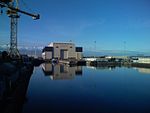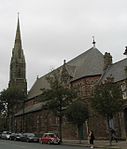Devonshire Dock Hall
BAE Systems facilitiesBarrow-in-Furness port and shipyardBuildings and structures in Barrow-in-FurnessIndustrial buildings completed in 1986Industrial buildings in England ... and 3 more
Trident (UK nuclear programme)Use British English from November 2017Vickers

Devonshire Dock Hall (often abbreviated to DDH) is a large indoor shipbuilding and assembly complex that forms part of the BAE Systems shipyard in the Barrow Island area of Barrow-in-Furness, Cumbria, England.
Excerpt from the Wikipedia article Devonshire Dock Hall (License: CC BY-SA 3.0, Authors, Images).Devonshire Dock Hall
Cornmill Crossing,
Geographical coordinates (GPS) Address External links Nearby Places Show on map
Geographical coordinates (GPS)
| Latitude | Longitude |
|---|---|
| N 54.1104 ° | E -3.2374 ° |
Address
Devonshire Dock Hall
Cornmill Crossing
LA14 2LJ , Hindpool
England, United Kingdom
Open on Google Maps










